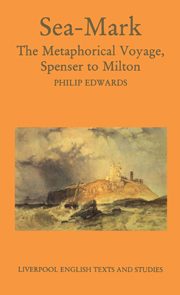Book contents
Introduction
Summary
This book is a comparative study of the use made by six writers of the sixteenth and seventeenth centuries—Spenser, Marlowe, Donne, Shakespeare, Bacon, Milton—of the traditional metaphor of the voyage, perhaps the commonest metaphor in literature, going back beyond Horace, who warned the battered ship of state not to venture out into stormy seas (Odes, I, xiv), and going on beyond Hardy's ‘Convergence of the Twain’, which made the loss of the Titanic a symbol of the workings of the Immanent Will. It seems to me that in the period I am concerned with the metaphor had, in the work of some writers at least, a special vitality, and that new energy and meaning were injected into convention and cliché. It is obvious that there ought to be some connection between this vitality and the fast-increasing activities of English ships at sea during this time: the voyages of discovery, trading voyages, expeditions against Spain and her shipping, voyages to create settlements in the New World. The year 1588 saw the defeat of the Armada and the triumphant retrurn of Thomas Cavendish from his voyage round the world, and in the following year Richard Hakluyt published the first version of his Principall Navigations, Voiages, and Discoveries of the English Nation. It is hard to think that the imagination of a writer in England at this time would not take some tincture from all this.
- Type
- Chapter
- Information
- Sea-MarkThe Metaphorical Voyage, Spenser to Milton, pp. 1 - 16Publisher: Liverpool University PressPrint publication year: 1997



